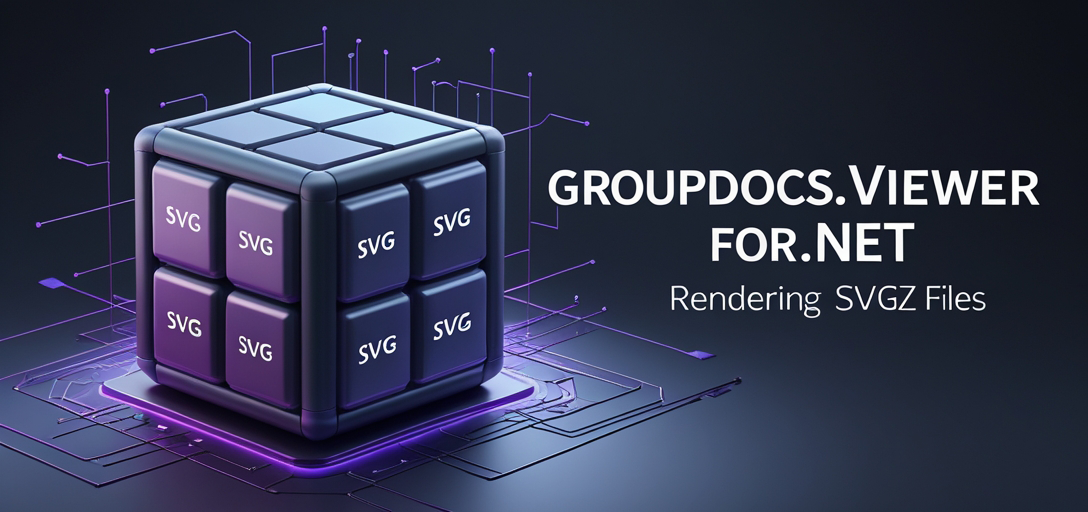Mastering SVGZ Rendering in .NET with GroupDocs.Viewer: A Complete Guide for Developers
Introduction
In today’s digital landscape, visual content is paramount. Managing and rendering vector graphics like SVG or compressed SVGZ files can be challenging, especially when integrating them into formats such as HTML, JPG, PNG, or PDF. This guide walks you through the seamless process of converting SVGZ documents using GroupDocs.Viewer for .NET. Whether you’re looking to enhance your web applications with high-quality images or streamline document workflows, this solution simplifies complex rendering tasks.

What You’ll Learn:
- How to set up and use GroupDocs.Viewer for .NET.
- Methods to render SVGZ files into HTML, JPG, PNG, and PDF formats.
- Best practices for optimizing your implementation.
- Practical applications in real-world scenarios.
Ready to dive in? Let’s explore the prerequisites first!
Prerequisites
Before rendering SVGZ files with GroupDocs.Viewer for .NET, ensure you have the following ready:
Required Libraries
- GroupDocs.Viewer for .NET version 25.3.0
Environment Setup
- A development environment supporting .NET Framework or .NET Core.
Knowledge Prerequisites
- Basic understanding of C# programming.
- Familiarity with file handling and directory management in .NET.
Setting Up GroupDocs.Viewer for .NET
To start rendering SVGZ files, install the GroupDocs.Viewer library. Here’s how:
NuGet Package Manager Console
Install-Package GroupDocs.Viewer -Version 25.3.0
.NET CLI
dotnet add package GroupDocs.Viewer --version 25.3.0
License Acquisition
GroupDocs offers different licensing options:
- Free Trial: Test the library with a free trial version.
- Temporary License: Request a temporary license for full access without limitations during your evaluation period.
- Purchase: Consider purchasing a license for continued use if satisfied with the capabilities.
Basic Initialization and Setup
Once installed, initialize GroupDocs.Viewer to prepare for rendering tasks. Here’s a simple setup in C#:
using GroupDocs.Viewer;
using System.IO;
string documentPath = "YOUR_DOCUMENT_DIRECTORY/Sample.svgz";
string outputDirectory = Path.Combine("YOUR_OUTPUT_DIRECTORY", "RenderingHTML");
if (!Directory.Exists(outputDirectory))
{
Directory.CreateDirectory(outputDirectory);
}
With this setup, you’re ready to explore the various rendering features of GroupDocs.Viewer.
Implementation Guide
Rendering SVGZ to HTML
Overview
Convert your SVGZ files into interactive HTML documents with embedded resources for easy web integration.
1. Define Output Directory Ensure the output directory exists:
string pageFilePathFormat = Path.Combine(outputDirectory, "svgz_result.html");
2. Configure Viewer and Options Set up the viewer and specify HTML rendering options:
using (Viewer viewer = new Viewer(documentPath))
{
HtmlViewOptions options = HtmlViewOptions.ForEmbeddedResources(pageFilePathFormat);
// Render SVGZ to HTML with embedded resources.
viewer.View(options);
}
Explanation:
HtmlViewOptionsconfigures the output format. UsingForEmbeddedResourcesensures all assets are included within the HTML file.
Rendering SVGZ to JPG
Overview
Generate high-quality JPEG images from your SVGZ files for use in digital media or print.
1. Define Output Directory Set up the directory for JPG outputs:
string outputDirectoryJpg = Path.Combine("YOUR_OUTPUT_DIRECTORY", "RenderingJPG");
if (!Directory.Exists(outputDirectoryJpg))
{
Directory.CreateDirectory(outputDirectoryJpg);
}
string pageFilePathFormatJpg = Path.Combine(outputDirectoryJpg, "svgz_result.jpg");
2. Configure Viewer and Options Initialize the viewer with JPG options:
using (Viewer viewer = new Viewer(documentPath))
{
JpgViewOptions options = new JpgViewOptions(pageFilePathFormatJpg);
// Render SVGZ to JPG.
viewer.View(options);
}
Rendering SVGZ to PNG
Overview
Convert your SVGZ files into PNG format for high-resolution displays or editing.
1. Define Output Directory Prepare the directory:
string outputDirectoryPng = Path.Combine("YOUR_OUTPUT_DIRECTORY", "RenderingPNG");
if (!Directory.Exists(outputDirectoryPng))
{
Directory.CreateDirectory(outputDirectoryPng);
}
string pageFilePathFormatPng = Path.Combine(outputDirectoryPng, "svgz_result.png");
2. Configure Viewer and Options Set up PNG rendering:
using (Viewer viewer = new Viewer(documentPath))
{
PngViewOptions options = new PngViewOptions(pageFilePathFormatPng);
// Render SVGZ to PNG.
viewer.View(options);
}
Rendering SVGZ to PDF
Overview
Create portable and scalable document versions from your SVGZ files.
1. Define Output Directory Prepare the directory:
string outputDirectoryPdf = Path.Combine("YOUR_OUTPUT_DIRECTORY", "RenderingPDF");
if (!Directory.Exists(outputDirectoryPdf))
{
Directory.CreateDirectory(outputDirectoryPdf);
}
string pageFilePathFormatPdf = Path.Combine(outputDirectoryPdf, "svgz_result.pdf");
2. Configure Viewer and Options Configure PDF rendering:
using (Viewer viewer = new Viewer(documentPath))
{
PdfViewOptions options = new PdfViewOptions(pageFilePathFormatPdf);
// Render SVGZ to PDF.
viewer.View(options);
}
Practical Applications
Leveraging GroupDocs.Viewer for .NET in various contexts can enhance your applications. Here are some use cases:
- Web Development: Embed interactive vector graphics into web pages with seamless HTML rendering.
- Digital Marketing: Use high-quality JPG and PNG images for marketing materials or social media posts.
- Document Management Systems: Convert SVGZ files to PDFs for easy distribution and archiving.
Integrating GroupDocs.Viewer with other .NET frameworks can further extend its capabilities, such as ASP.NET for dynamic web applications or WPF for desktop solutions.
Performance Considerations
Optimizing performance when using GroupDocs.Viewer involves several strategies:
- Resource Management: Ensure efficient use of memory and disk space by managing output directories effectively.
- Batch Processing: Render files in batches to minimize resource usage spikes.
- Caching: Implement caching mechanisms for frequently accessed documents.
Following these best practices ensures smooth operation, even with large volumes of data.
Conclusion
By now, you should have a solid understanding of how to render SVGZ files into various formats using GroupDocs.Viewer for .NET. This tool simplifies complex rendering tasks and opens up numerous possibilities for enhancing your applications.
Next Steps:
- Experiment with different configuration options.
- Explore additional features of GroupDocs.Viewer in the documentation.
Ready to try it out? Dive deeper into the resources below!
FAQ Section
What is SVGZ, and why use GroupDocs.Viewer for rendering?
- SVGZ is a compressed version of SVG, ideal for efficient web usage. GroupDocs.Viewer offers robust conversion capabilities across multiple formats.
Can I render other file types with GroupDocs.Viewer?
- Yes, it supports over 90 document formats including Word, Excel, PDF, and more.
How do I handle large SVGZ files efficiently?
- Optimize performance by utilizing batch processing and caching strategies.
Is GroupDocs.Viewer suitable for enterprise applications?
- Absolutely. It provides reliable conversion with scalable licensing options for businesses of all sizes.
Where can I find more advanced features or support?
- Visit the official forums and documentation for additional guidance.